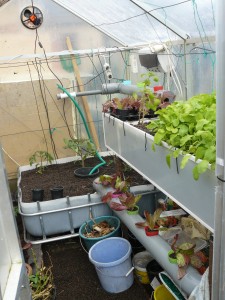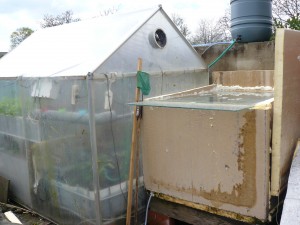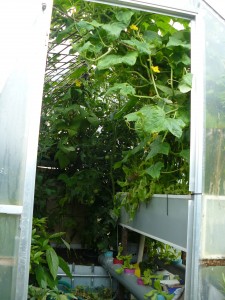eigen systeem 2012own system 2012
Omdat het in de aard van de mens ligt, is wat verandering, en vooral verbetering, niet uitgesloten.
We gingen in 2012 voor vergroting van het systeem: een 700 liter tank voor veel vis (en als het even kan de Omega-baars), en meer dan 1m² extra groeibed.
Alles wordt opgebouwd met een IBC, ofte ‘watertankt op een pallet in een kooi’. Die dingen zijn goedkoop en heel gemakkelijk voor een AP systeem!
Meer informatie over de bouw van het systeem kan je hier vinden.
Zo werkt ons nieuw systeem:
1. Het waterniveau in de tank blijft ongeveer gelijk. Bij het inpompen van vers water, loop het vuil water (dat vol voeding zit) over via de overloopbuis (die onderaan vertrekt om vuil mee te zuigen) naar de kreeftenbak.
2. Het water loopt via een dikke buis naar de kreeftenbak. In deze buis staan al wat potjes met kruiden. Net zoals overal in het systeem zetten nutrificerende bacteriën de ammoniak an ammonium om in nitrieten. Andere bacteriën zetten de nitrieten om in nitraten en deze dienen als voeding voor de planten.
3. Het water loopt van de kreeftenbak over naar het eerste plantenbed. Hierin staat lava en verschillende planten, zoals radijzen, komkommer, augurk, pilipili, stevia en jonge pluksla. De planten nemen voeding op en filteren het water.
4. Via de autosifon loopt de eerste plantenbak in één keer leeg in het onderliggende buizenstel. Hierin staan potjes kropsla die met de wortelen in het water hangen.
Via een overloop en tweede auto-sifon loopt het water naar het tweede groeibed.
5. Het tweede groeibed is gevuld met Argex (geëxtrudeerde kleikorrels). Dat werkt wat gemakkelijker dan de lava. In het bed staan tomaten en komt nog wel wat. Ook hier nemen de planten de nitraten uit het water op en zuiveren dit water verder.
6. Via het tweede bed loopt het gezuiverde water in een centraal buffertankje waar de pomp in staat. Bij een optimaal gebalanceerd systeem zuigt de pomp steeds water aan en fluctueert het waterpeil door de instroom van water. Net zoals de andere bedden is dit nodig om zuurstof aan de wortels te brengen. Omdat mijn eerste bakken kleiner zijn dan de tweede moet ik wellicht een waterniveau detectie doen en de pomp aanschakelen als de bak vol is en uitschakelen ans de bak bijna leeg is. Dan moet er wel een zwaardere pomp komen. Voorlopig hou ik het hierbij: het water fluctueert zo’n 15 cm.
7. De pomp pompt het zuivere water terug in de vistank.
8. Uiteraard is veel zuurstof nodig voor de werking van de bacteriën en voor gezonde vissen. Er staat een grote luchtblazer in de vistank én in de kreeftenbak.
9. De ‘vervuiling’ moet van ergens komen: De vissen worden gevoed met voeding dat 98% plantaardig is. In veel visvoeding zit vismeel, en dat is niet zo ecologisch verantwoord. Bovendien bevat dit vismeel zout, wat een nadelige werking heeft op de plantengroei.As it is in the nature of human beings, some change, and in particular improvement, can not be ruled out.
In 2012, we aimed for enlargement of the system: a700 liter tankfor many fish (and if possible the Omega-perch), and more than1m² extra grow bed.
Everything is built with an IBC, or ‘water tank on a pallet in a cage’. Those things are cheap and easy for an AP system!
More information about the construction of the system can be found here..
This is how our new system works:
1. The water level in the tank will remain approximately the same. When pumping in fresh water, the dirty water flows (full of nutricion) through the overflow tube (leaving at the bottom to suck dirt) to the lobster tank.
2. The water runs through a thick tube to the lobqster tank. In this tube, jars with herbs are placed. Like everywhere in the system nitrifying bacteria convert the ammonia and ammonium into nitrites . Other bacteria convert the nitrites to nitrates, and these serve as nutrition for the plant.
3. The water runs from the lobster tank into the first plant bed. This is filled with lava and various plants, such as radishes, cucumber, pickle, pilipili, stevia and young letuce. The plants absorb food and filter the water.
4. Via the auto sipho,n the water flows a once to the underlying tubular system. This contains lettuce pots with the roots hanging in the water.
Via an overflow, and the second auto-siphon the water runs into the second grow bed.
5. The second groeibed is filled with Argex (extruded clay granules). That is a bit easier than the lava. In the bed we planted tomatoes, and some other stuff will be added. Here, too, the plants take the nitrates out of the water and purify that water.
6. Through the second bed is the purified water sinks in a central buffer tank in which the pump is placed. In an optimally balanced system the water pump punms non-stop and the water level fluctuates due to the inlet of water. Like the other beds it is necessary to bring oxygen to the roots. Since my first beds are smaller than the second I might have to install a water level detection, switch on the pump when the tank is full and off as the tank is almost empty. This means heavier pumps dough. For now I love it as it is: the water fluctuates about 15 cm.
7. The pump pumps the clean water back into the fish tank.
8. Of course, a lot of oxygen is required for the growth of the bacteria and for healthy fish. There is a large air blower in the fish tank and in the lobster tank.
9. The ‘pollution’ must come from somewhere: The fish are fed with food from 98% vegetable origin. Many fish food contains fish meal, and it is not ecologically. Moreover, thi fish meal contains salt, which has an adverse effect on the growth of plants.


